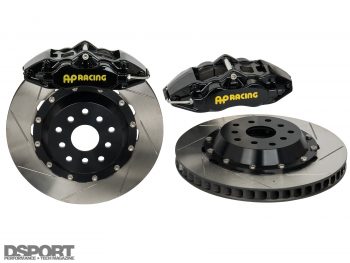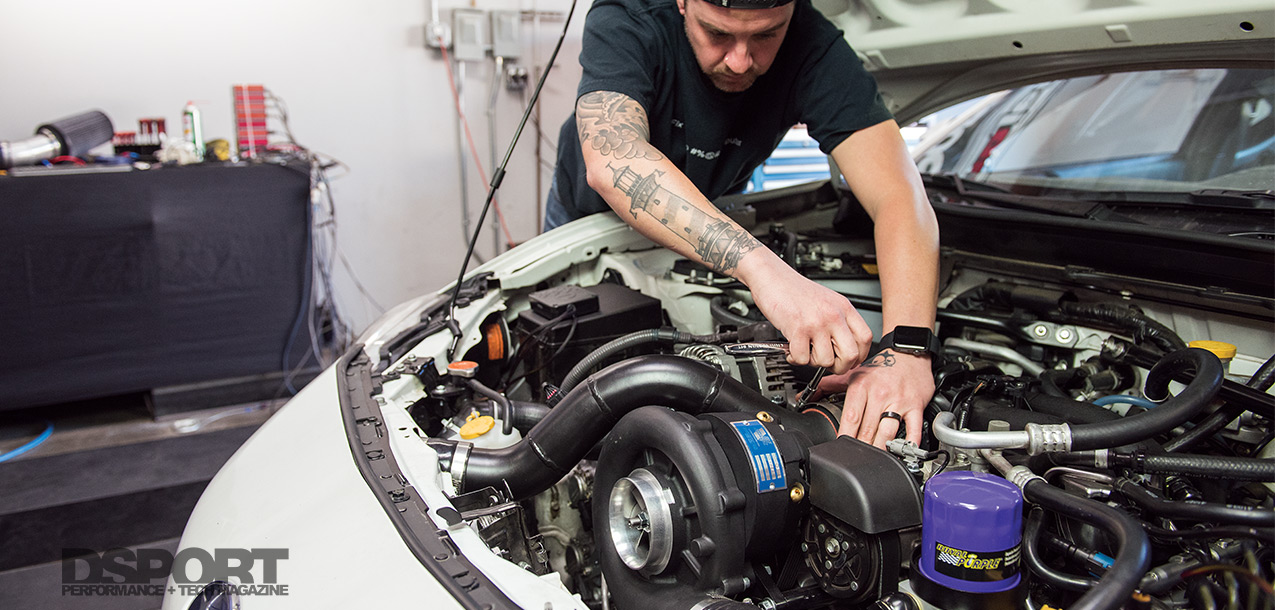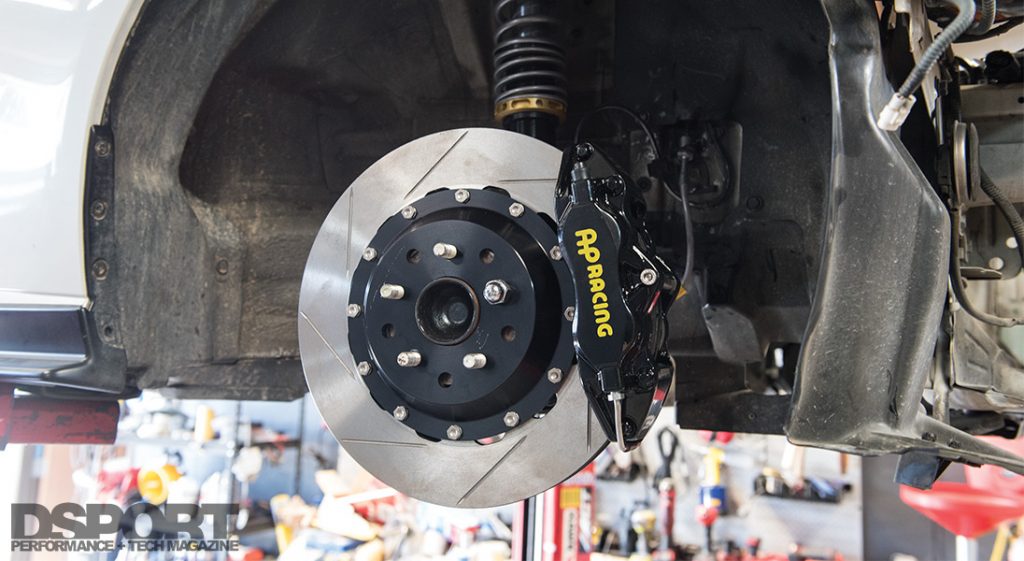If you decide to do it, do it right! When it comes to demo-cars, companies cannot afford to cut any corners. Such builds are made to be the cutting-edge of what can be done with that platform. There are no limits. Every part for that car is intended to be the best one possible, showing that the company is only in it to outdo everyone else’s build. To display the essence of its business, LA Sleeve asked DSPORT to build a demo-car that will represent them properly. LA Sleeve has been in the business of sleeving engines for both performance and repairs for over seven decades. To truly show what the performance side of their business is all about, a stock 2015 Subaru BRZ was the car of choice, but the word “stock” was soon to vanish from the conversation.
Text by Bassem Girgis and Cameron Parsons // Photos by Joe Singleton
DSPORT Issue #192
Our dyno testing of a Club DSPORT built FA20 has shown that our goals are achievable when using a turbocharger. Now, we propose a supercharged 2.25-liter FA20 that is both powerful and durable.
Star of the Show
On the main stage at Club DSPORT, the stock BRZ had a fresh FA20D. Many have argued that the 2.0-liter motor is rather weak in its stock form. The FA20 delivers 170 horsepower and 150 lb-ft of torque, which makes the 2,800-lbs car more of a momentum car. Momentum is not what we are looking for, however, and since the LA Sleeve build will serve as a demonstration of power and capability, we had to take the BRZ to completely new heights and force some much-higher power out of it.
The Goals
LA Sleeve intends for its BRZ to provide more than 500 horsepower out of a built and supercharged FA20. In issue #187, “Stop the Swap,” we focused on the FA20 and why you should consider rebuilding one of these engines instread of performing a motor swap. While tuners have chosen to swap the 2.0-liter engines with everything from an LS to a 2JZ, and even a Ferrari 458 engine; we decided to stay loyal to the FA20. The goal is to build a complete, powerful BRZ that can not only reach the 500whp mark, but to also handle just as well. So, before starting on the engine, we turned our attention on the chassis, suspension, and brakes with the help of Peter Yeung at LMR Development to better handle the increased engine performance.
The MAXG coilovers from Whiteline were chosen for their ability to maintain suspension geometry under heavy lateral and braking loads on the track without being overly stiff when driving on the street.
Staying Grounded
For any well-built demo-car, the goal is not to show how fast the car can go from 0 to 60 mph. The goal is to show how complete the car is. We will be increasing the engine power by almost three times that of stock, which means we had to lower the car’s height to improve its center of gravity and improve transitional weight transfer rates under various racing driving modes. Whiteline MAXG were chosen for our coilovers. The MAXG offer 30-60mm height adjustment for both the front and the rear, allowing us to control the height for various racing needs. The coilovers feature a 44.5mm diameter damper bore, which eliminates bending due to the increased surface area loading. The extra width on the dampers strengthen the hardware, enabling them to withstand higher lateral forces during hard corners. This also comes with the benefit of heat-dissipation characteristics to keep the shocks performing reliably and consistently.
Tight Handling
 In order to improve the suspension further, we had to get rid of the factory bushings. The stock bushings are made from fairly soft rubber that serve the stock car well, simply incorporated to absorb the energy transmitted from the road to provide a comfortable ride on the streets. However, as the engine power increases, we have to anticipate the high speeds and quick maneuvering. We replaced the stock bushings with ones from Whiteline. The more race-ready bushings reduce slop and flex where various suspension components interconnect. This improves responsiveness, gives better road
In order to improve the suspension further, we had to get rid of the factory bushings. The stock bushings are made from fairly soft rubber that serve the stock car well, simply incorporated to absorb the energy transmitted from the road to provide a comfortable ride on the streets. However, as the engine power increases, we have to anticipate the high speeds and quick maneuvering. We replaced the stock bushings with ones from Whiteline. The more race-ready bushings reduce slop and flex where various suspension components interconnect. This improves responsiveness, gives better road
feedback to the wheels and the driver’s seat,
and offers greater durability than the stock rubber bushings.
The rear suspension was replaced with adjustable components from Whiteline. The lightweight rear lower control arms have +/- 2.5 degrees of camber adjustment, while the rear toe arms allow for precise tuning of the toe alignment.
As any car increases its speed on track, stability becomes essential. While the front end of the BRZ will be aligned with a small amount of toe-out for improved response, the rear-end needs some toe-in to keep the car stable at high speeds. Whiteline KTA147B rear toe arms replaced the factory arms, allowing for precise toe alignment to keep the car driving straight when needed. With the suspension upgraded to support the 500 horsepower goal, there were only a few things left to do before we turn our attention to the engine performance.
Stopping Power
 As for all other components on the car, the stock brake system was designed to support the car well in its stock form. However, with the end goals in mind, we knew we had to completely upgrade the brakes for safety. Stock calipers are structurally not stiff enough for higher line pressure at high speeds, which could result in front-wheel lock. We selected one of the most capable brake systems available for the BRZ: the AP Racing Big Brake Kit by Stillen. The kit comes with 4-piston calipers, which offer consistent clamping pressure across the entire pad area that contacts the rotors, as opposed to a floating piston design. The high temperatures that a 500hp track car can generate will take a toll on stock rotors and pads, this can lead to brake fade and even warped rotors. The larger two-piece rotors that come with the AP Racing kit are just right for the task. The two-piece design is typically lighter than the one-piece rotor design. The rotors are slotted, which direct hot gases away from the pads and the discs’ surface. It also wipes excess pad material and debris away, keeping both surfaces smooth and effective. To reduce expansion of the brake lines, we installed stainless-steel lines. The stainless lines improve the pedal feel and consistency, and reduces pedal travel under heavy braking.
As for all other components on the car, the stock brake system was designed to support the car well in its stock form. However, with the end goals in mind, we knew we had to completely upgrade the brakes for safety. Stock calipers are structurally not stiff enough for higher line pressure at high speeds, which could result in front-wheel lock. We selected one of the most capable brake systems available for the BRZ: the AP Racing Big Brake Kit by Stillen. The kit comes with 4-piston calipers, which offer consistent clamping pressure across the entire pad area that contacts the rotors, as opposed to a floating piston design. The high temperatures that a 500hp track car can generate will take a toll on stock rotors and pads, this can lead to brake fade and even warped rotors. The larger two-piece rotors that come with the AP Racing kit are just right for the task. The two-piece design is typically lighter than the one-piece rotor design. The rotors are slotted, which direct hot gases away from the pads and the discs’ surface. It also wipes excess pad material and debris away, keeping both surfaces smooth and effective. To reduce expansion of the brake lines, we installed stainless-steel lines. The stainless lines improve the pedal feel and consistency, and reduces pedal travel under heavy braking.
The AP Racing Big Brake Kit by Stillen is a 330mmx25mm two-piece rotor design with aluminum hats for superior heat dissipation. A four-piston caliper provides superior, consistent clamping force over the stock braking system. The upgrade has DOT-compliant braided stainless-steel brake lines for improved pedal feel and stiffness.
Onto The Next Phase
The road to the 500 horsepower LA Sleeve BRZ started with a solid foundation. With a robust suspension system and a great brake system, we are finally ready to confidently take the engine to new heights. To get the engine where we want it to be, we will need to completely disassemble it, precisely machine the block to accept the sleeves, and upgrade the weak-links that will require additional strength and durability. Targeting 500whp with a centrifugal supercharger is a new territory waiting to be explored more, and with our use of the Vortech Supercharger along with the block machining and engine modifications, we are out to prove that the FA20D may be small in size, but it surely is capable.
| Parts List | |||
| Part Name | Brand | Model | Price |
| Big Brake Kit | AP Racing | R/T Front | $3,300.00 |
| Front and Rear Sway Bar Kit | Whiteline | BSK020 | $494.82 |
| Rear Control Arms Upper Inner Bushings | Whiteline | KCA326 | $152.82 |
| Rear Control Arms Upper Bushing | Whiteline | KTA216 | $251.82 |
| Front Control Arm Bushing | Whiteline | KTA147 | $314.82 |
| Front Camber Bolts | Whiteline | KCA434 | $134.82 |
| Gearbox Shift Kit | Whiteline | KCA416 | $35.82 |
| Rear Diff Mount in Cradle Bushing | Whiteline | KDT926 | $31.32 |
| Rear Subframe Mount Bushing | Whiteline | KDT924 | $116.82 |
| Rear Diff Mount in Cradle Support Outrigger | Whiteline | KDT921 | $116.82 |
| Rear Diff Mount Support Outrigger Bushing | Whiteline | KDT925 | $53.82 |
| Rear Subframe Mount Insert Bushing | Whiteline | KDT923 | $53.82 |
| Crossmember Mount Bushing | Whiteline | KDT922 | $40.32 |
| Coilover Shocks | Whiteline | MG1-SUB006 | $2,564.99 |
| Total: $7,662.83 | |||







